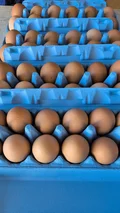TL;DR
Today it was just the three of us. We started in the greenhouse seeding lettuce trays. Then I went up to the barn to learn how to clean and pack eggs, 64 dozen cartons. Then we seeded and potted up more trays in the greenhouse.
Egg Economics
When the national average price per dozen eggs is $6.27, the organic cage-free kind at $8.49…this is around $540 worth of eggs and 3-4 hours (around $60 of labor) about twice a week. I’m not yet sure how many chickens are laying now, how many are needed for the summer CSA, and how many need to be replaced/ordered per season.
In a future post, I’ll do research and a detailed breakdown of the variables involved in calculating the total cost and projected revenue from the chickens. They also are moved around in a mobile chicken coop across various parts of the field as high-nitrogen fertilizer throughout the year.
During summer CSA, the chickens should be laying at least enough for a dozen in a carton per full member-share equivalency bag. We should always have more to sell extra and ad-hoc at farmers markets. In general, farm-fresh eggs have deeper yellow yolks and while not exactly the same size or color like the boring ones in the store, the uniqueness is also a selling point.
The eggs get washed not simply because it is the law in Massachusetts (General Law Part 1 Title XV Chapter 94 Section 90A), but because customers deserve high quality eggs that look clean and are inspected for quality. Careful attention to eggs is important because come cracks are hard to identify if working too quickly.
Seeding and Potting Up
Back at the greenhouse, we seeded multiple varieties of lettuce and some basil, then potted up pepper starts from trench trays to 2 inch cell trays. For the lettuces, we used 98 cell (7x14) plastic trays with mesh flats underneath. On a large table at the front of the greenhouse (8x4 foot plywood sheets on saw horses), potting mix is mounded up. Empty trays get handfuls of the mix on them and brushed with the hands until all cells are full but not compacted. With all fingers in a horizontal row, divots are made in the cells from far to near a few times to make space for seeds. Many of these trays can be done in preparation for the seed stage. The basil seeds went in small 2 inch “paper pots” and will grow that way in the greenhouse until large enough to put in CSA member shares.
The hardest part of this work is on the neck…when looking down at one’s hands for a few hours, between egg washing and seedling trays…the muscles in my back between my shoulder blades are sore today. At least my lower back got a break from field planting which we’ll likely do tomorrow.
Tech Note: Context is Everything with LLMs
Between yesterday (my first official day) and today, yesterday’s automatic summary based on my audio notes were a bit…incomplete. I realized that the map-reduce LLM prompt templates I was previously using in Autoscribe (my custom code) were too generic…effectively it didn’t have context that the nature of the audio recording was personal notes (single-person dialog) from a specific persona / perspective (a farm intern about daily work) and should include a more precise set of outcomes.
I realized that the outcomes I need to speed these blog posts are A) activities performed, B) new things learned or encountered, C) questions I might ask in the future about these areas of work, and C) what to remember tomorrow.
The good news is that, while the transcribing process is the slowest because I lack a modern GPU, it only has to be done once and I can regenerate the summaries from them given new/improved templates whenever I want. Also, various layers of context should be aggregated and included in the summarization process throughout the season, similar to what online services automatically do whenever you use them.
It’s a hobby system and there’s plenty to tweak on the weekends.
[end of post]
Enjoy Reading This Article?
Here are some more articles you might like to read next:

